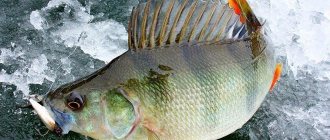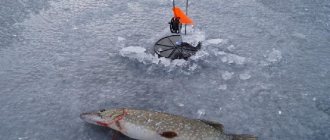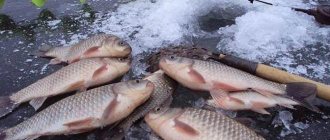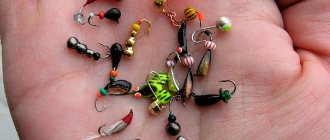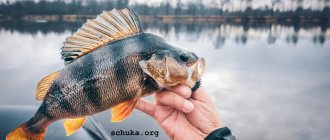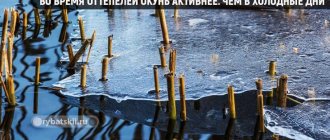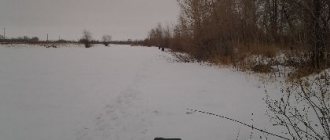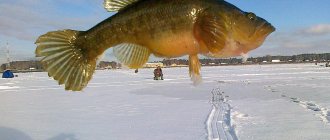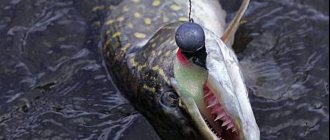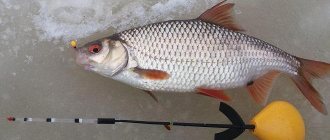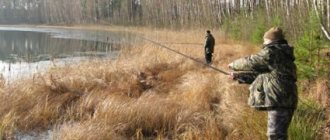Until recently, catching perch with a reelless bait on the first ice could not compete with a baited jig in popularity. However, now more anglers, especially urban ones, are switching to baitless fishing. The absence of bloodworms and other baits speeds up the process of preparing for fishing. You don't always need to drag a sled with a bunch of gear. For quick fishing near home, one fishing rod and a set of jigs are enough.
Perch on the first ice makes it possible to easily enter the reelless bait - during periods of famine it is easy to catch, some mistakes in the equipment and wiring of the jig are acceptable. Naturally, this does not always happen and not everywhere - there are important rules and trends in such fishing.
No bait for perch
In reservoirs that are not too pressed, perch confidently takes the first ice with a reelless bait. The point of tactics for active fish is to find working points and choose the right reelless reel with a certain playing technique. But even on the first ice, the striped robber does not always readily respond to bait.
Sometimes the perch needs to be tortured by picking up jigs, combinations and provocations, running between the holes. Therefore, if the goal is stable catches, and not a walk on the ice, you need to understand the features and nuances of reelless perch fishing. Read more about winter fishing for perch with reelless reels
Catching roach on the first ice
On the first ice or first ice, roach actively moves in search of food. By this time, she gathers in flocks. Moreover, the following picture can be traced: in small lakes, ponds, quarries and medium-sized regulated rivers, schools of small roach are concentrated near algae, and mature roach, continuing to stay in scattered groups, chooses places with depressions on the bottom, often near snags.
As for large reservoirs, in them the main part of large roach, huddled in numerous flocks, migrates through the reservoir in search of food and future sites, often choosing places near zebra mussel plantations.
Roach on the first ice, especially large ones, can still enter bays with a depth of 2 to 3 m, but as the ice grows, they increasingly stick to deeper and more open places where the oxygen regime is better. Heat-loving roach prefers depth primarily because there is a maximum positive temperature.
In reservoirs, large roaches should be looked for in the bends of flooded rivers and streams - there they remain for a long time in areas with slow flows, especially if there are uneven spots or rocky ridges at the bottom, in which food washed away by the current can be retained.
Sometimes good spots can be found where a tributary channel adjoins the main underwater channel. In rivers with first ice, large roach are sometimes found near summer habitats, but after two to three weeks, if the weather is stable and frosty, they should be looked for where the water is better enriched with oxygen, that is, below water barriers, dams, drains, depths immediately following the rapids. In addition, in rivers, large roach often stay near the banks washed away by the current, usually on or near the edge at depths of 3.5 to 5 m.
On regulated rivers, canals and reservoirs, where the filling level of the reservoir is not constant, roach positions can change: when the water is high, the roach often stands in front of the channel irrigation, but when the level decreases, it can roll into the riverbed or channel pits.
Often roach on a fairly monotonous vast area of the bottom chooses some feature. It can be a luda, a funnel or a tubercle, a separate snag. In any case, preference should be given to those places that stand out in some way.
For example, on the Fidyakinsky pond, which is located not far from the Rastorguevo station, you can almost always find a large roach where some kind of snag lies at the edge of a flooded river bed, and, say, on the Golubinskaya dam, roach is well caught near individual bushes, which also The flooded riverbed is approaching close. It should be taken into account that this fish avoids stagnant, heavily silted places. She feels more comfortable in areas with a sandy and rocky bottom. At depths near steep shores, the choice of location can be guided by rock outcrops.
Having discovered a place where roach are concentrated, you should mark it, for example, with small twigs, set the depth and, if necessary, feed the place.
Catching large roach on the first ice
It has been noticed that large roach does not like places that are too lit, so in rivers it often stays under shaded steep banks, fallen trees and branches of submerged bushes.
When the ice is still transparent and the fish sees everything that happens on its surface, even small roach are frightened by uninvited guests, leaving their usual place. In this case, it is necessary to mask the ice or select areas with a matte surface. But even then, when quite a lot of snow has already fallen, from which it becomes dark under water, the drilled hole must be shaded, that is, covered with snow and a small hole made in it so that the jig can be freely lowered into the water.
Large roach does not like noise and conversations on the ice, and where there are many fishermen, it seems to wait for them to leave. I remember that on Zusha in the Mtsensk region we sat all day in a crowd of fishermen, periodically catching roach, and only in the evening, when the ice was empty, did we finally wait for a bite from a heavier roach. The same thing happened more than once on the Sebla, Sutka, Sukhovetka - rivers flowing into the Rybinsk Reservoir. However, the evening bite is short-lived. Usually, with the onset of darkness, it subsides or may occasionally resume on baited holes intended for night bream fishing.
How to deal with the weather when fishing for roach on the first ice
The roach bite largely depends on changes in atmospheric pressure, which very rarely remains unchanged in winter. Roaches are most active when the pressure does not change for several days or drops very slowly from approximately 742 to 737 mm Hg. It has been noticed that on the Tsaritsyn ponds the roach bites best during periods when the barometer shows 738 mm of mercury.
Roaches love cloudy weather. It is advisable that there is no wind during the fishing period, and if it does blow, it should be from a weak western or southwestern wind. Often roaches bite well when small wet snow falls. Sometimes this fish bites well during a rainy thaw. But in severe frosts and sudden changes in atmospheric pressure, the roach becomes inactive and loses its appetite. At such times, getting her to be seduced by bait or bait is not at all easy.
Behavior of perch on the first ice
In some reservoirs, immediately after the first ice forms, the perch bites perfectly, but in others, not so much. In some places, the striped fish stabilizes in the bite a week or two after the formation of ice. The bite may be uniform throughout the day, but more often the activity of the predator in each specific body of water falls and increases according to a schedule unique to that place.
The tendency is to search and fish from the coastal strip. The fry has not yet rolled down to the depths on the first ice. The food supply is located near the shore, in the thickets or in close proximity to them. Perch will also be circling here.
Even large perch during this period can be found not in holes, but in relatively shallow water not far from the shore. On small rivers - anywhere, since there are any places - not far from the shore and thickets.
Perch on the first ice with a reelless fish is, first of all, an active search. If you're lucky, you might stumble upon a cauldron of fattening perch. Then all that remains is to select the desired reelless reel, game, and catch. But not in all reservoirs the perch gathers in large schools.
Sometimes striped fish walk around the water area in small groups - then you will have to move and drill, search again when the bite dies down after catching several individuals.
Read more in the article about perch in the first ice:
Perch activity period
When ice forms, schools of perch do not go far from the shore and prefer to catch fry near reeds and aquatic vegetation that has not yet fallen to the bottom. The predator actively feeds until the last days of December, but this depends on the size of the reservoir, the presence of current and oxygen. Under favorable conditions it is active.
During the day, you can count on a good bite in the morning hours from sunrise to 12 o'clock, then the bite subsides and becomes more active from three hours to sunset.
Tactics for searching and catching with a reelless reel
So, searching for and catching perch on the first ice always means actively moving and exploring new points. Only in rare cases can you sit on one hole and catch a lot - if you find a large school of perch feeding in a specific place. In other cases, we walk, drill, check any promising places and points.
Selecting a location
Promising search places for winter fishing for perch on the first ice with a reelless reel:
- Coastline with reeds, depths from 0.5 to 3 meters.
- A fall from the wall of vegetation into the depths.
- Snags and flooded bushes, especially if they border on depth.
- Any anomalies - areas with reverse flow, irregularities on the bottom, bushes hanging over the water, deep areas near the shore. That is, all promising areas where perch caught in open water in the fall.
- Standard points on big water are entrances and exits from holes, edges and drop-offs into the riverbed, snags and logs at the bottom.
- Any irregularities at medium depths, navels and streamers emerging from the depths, especially with algae.
Hole drilling tactics
In order for fishing on the first ice for perch without bait to be successful, after arriving at the reservoir you need to evaluate the place strategically and make a plan in your head, at least at the initial stage of the search. There is no need to wander around chaotically and search.
We move and drill intelligently - from the shore into the depths in order to find the desired horizon, along a drop off or near specific landmarks. If there is nothing to attach to - the shore is far away and the bottom topography resembles the lunar one - we drill square by square using the square-cluster method, in a checkerboard pattern.
- Perch is active on the first ice, approaching objects of interest from afar. Therefore, it makes no sense to drill more often than 7-10 meters apart. You can drill closer, for example, next to the fishing hole if the bites have stopped. Or when examining a specific shelter - snags, pipes, bushes.
- On small bodies of water without promising places immediately visible to the naked eye (bushes, snags), we drill from the shore perpendicularly. We are looking for the depth at which the perch stands. From those holes where we managed to catch a striped fish, we move parallel to the shore, at a certain bottom level.
Quickly check holes and catch
We check the holes with proven rewinders. First, we make several amplitude transactions, similar to the game of a balancer. The goal is to collect the striped one from afar with strong vibrations. This is the so-called swinging of the hole. During periods of activity, the perch sometimes takes it as soon as the reeler reaches the required level. After swinging (2-3 cycles) we perform several basic perch combinations. No bites - we move on.
- There is no point in lingering over the hole if it doesn’t bite. It's better to move on and look for work points. On some reservoirs, anglers use bait, collecting striped fish at a point with bloodworms or jigs. Others like a pure rewinder - only searching, no feeding.
- If there is a bite, and even more so, if a perch is caught, we stay at the point longer. It is important not to waste time in case it is a passing flock. The rewinder immediately sinks back into the water. In some cases, you manage to catch a few more fish. In others, perch begins to be caught consistently from one place. Therefore, we continue to act according to circumstances.
- If the bite has stopped, there is no use in hatching. We need to look further. Hatching and changing baits helps when the perch is passive and standing. On the first ice, the disappearance of the bite is an obvious signal that the fish has left (caught if there was only a small school).
An article about the general patterns of winter perch fishing:
Selecting a location
Good places for baitless fishing in winter can be:
- borders of thickets of aquatic vegetation;
- eyebrows;
- pits and pits;
- elevations of the bottom that stand out on a flat terrain - “navels”;
- snags.
Fishing locations in winter are constantly changing. If the reservoir has been studied far and wide, it is advisable to find out where, at what points, shallow or deep, it will feed on a specific day. To do this, upon arrival at the pond, it is worth drilling holes in several different areas to check them and determine where the most bites occur.
If the reservoir is new to you, as are the habits of its inhabitants, there are two options:
- After arriving at it, find fishermen who are successfully fishing and drill next to them.
- Drill as many holes as possible in different areas and check them all one by one.
Active search is the key to success when fishing with baitless bait. The rule “the more you walk, the more you’ll catch” is more relevant here than anywhere else. The rewinder usually does not require pre-feeding the point. This means that when fishing with it, nothing prevents you from moving a lot around the reservoir. This opportunity should not be neglected.
Finding active fish is the hardest part of bait fishing. Once its position has been determined, getting it to peck is a matter of technique. It is better to look for fish with a partner or several friends at once. In this case, you can check more places in a short time. As a result, points that are promising for fishing on that particular day will be discovered faster.
When searching, 5-6 wires in a hole are enough to determine whether there is fish here or not. On days when underwater inhabitants are active, it is enough to pass the bait 2-3 times.
Reelless tackle for perch on the first ice
Reelless fishing uses thin and neat fishing rods, monofilament no more than 0.14 mm. In the rig, a single system is formed, consisting of a jig and a fishing line thickness matched to its weight and a nod adjusted for elasticity. The fishing rod itself is a lightweight sports class or homemade one. Options for nodule-free equipment are also possible, when the bite and play of the jig is felt in the hand.
Proper equipment of a reelless fishing rod is the most important condition for success in this type of fishing. There are no bloodworms on the hook, and a bite can only be achieved by flawless action of the bait. And such a game is possible only with the right equipment. Equipment without a nozzle is a separate issue.
Discussed in detail in this article:
https://podlednik.ru/snasti/bezmotylka/udochki-dlya-bezmotylki
Tips and secrets
Fishing of different horizons
Fishing in most cases occurs in the lower layer of water. The bait is lowered to the bottom, and then the retrieval begins. But the reelless reel allows you to fish any horizon of the water column. Don't miss this opportunity.
Perch, roach and other fish often bite in the middle or even upper layers of water in winter. If there are no bites at the bottom, you should go higher. It is even more correct to immediately check all horizons, from the bottom to the subsurface, immediately upon arrival at the reservoir. When the bites start, it will be possible to determine where the fish are holding that day.
The nuances of correct wiring
The shallower the depth and strength of the current in the fishing area, the easier it is to achieve the correct play with the bait. Air temperature also greatly influences it. The stronger the frost, the more intensely the water freezes and sets on the surface of the hole, and this makes it difficult to place the bait.
Fishing, as a rule, takes place at shallow depths, up to 2–3 meters. Under such conditions, you can easily set even a small rewinder to oscillate at any amplitude and frequency. This can be a fast, sharp game. If fishing takes place at a depth of 7–10 m, it is difficult to perform a high-frequency game.
But in most cases this is not required. In such conditions, bream is usually caught, which responds well to smooth play with bait.
Much depends on the gear. For proper wiring, it is important that the fishing line is thin enough.
A nozzle-free jig, no matter how light it is, should pull it into an even line.
Working jigs
You can find a lot of reelless baits, both store-bought and homemade. Here we can draw an analogy with wobblers in spinning rods. Each trick often requires its own approach, nod adjustment and play. There is no best all-around bass reel - there are too many variables. In some conditions one works better, in others – a completely different one. In addition, in the hands of two anglers, the same bait can work differently.
In the reelless version, you can fish with ordinary drops, pellets, urals, bugs, by placing artificial elements on the hook - threads, beads, seed beads, plates. There are also many models of various colors and shapes, specially designed for baitless fishing - bananas, nymphs, maggots, larvae. The class of mothless creatures also includes all kinds of devils, goats, witches, cobras, and jellyfish.
Detailed article about types of reelless jigs
Newfangled nail balls and nail cubes are in trend now. In essence, it is an ordinary carnation with a decoration on a hook in the form of a bead of various colors and shapes. However, not all nail balls sold in stores are correct. The shape of the hook, the size, body parameters of the bait and the bead itself are important.
Catching perch with a nailball on the first ice is a great opportunity for a beginner to enter the world of reelless fishing. Firstly, this bait allows for glitches in the game, which is useful when your hand is still trained to play correctly. Sometimes it’s even useful to pause with this particular jig. Secondly, the first-ice perch is not picky and often grabs everything.
More details about jigs and nail balls:
Fishing for the devil
Perch on the devil takes no worse on the first ice than on other reelless baits. Short and medium-sized devils with beads on the tee are suitable. The wiring of the devil is smoother and dotted. Here it is more important not to achieve a high oscillation frequency, and not to allow a failure in the uniform wiring. Catching perch on the first ice with a devil is tactically no different from other types of reelless bait - the main thing is to find the predator’s camp and choose the right game. More information about winter fishing for perch using reelless devils
Balda
Another separate direction of reelless fishing is fishing with a balda. Catching perch on the first ice is the best time to use this equipment. The bait is a sinker with holes through which a loop of fishing line is passed. Hooks with beads move freely on the loop.
The main wiring is tapping on the bottom. The perch flies to the raised turbidity and sound, and attacks the hooks with provocateurs. On some winter reservoirs, fishing for perch with a cannon on the first ice is the main way of catching this predator among local fishermen.
Balda is a separate direction without bait, the weight of the bait is something between a jig and a spinner. Light weight, up to 3 grams, can be used on light fishing rods. But even a thirty-gram bait for depth and current is difficult to compare with ultra-light and neat ordinary reelless baits. This should be used already on tackle for trolling.
However, the nozzle is still not used. Therefore, the bulldozer is classified as a nozzle. And the catchability of this gear for perch is in no way inferior to others. Balda is a special tackle specifically for perch. But sometimes other fish are enough for suspended provocateurs, especially in the first ice.
More information about winter fishing for perch on the Baldu:
Flies and pussies
Perch has a highly developed food competition reflex. If someone is eating something nearby, the striped one will definitely poke his head in and try to take it away. Therefore, combinations of two baits are effective against striped fish - locomotives and tandems. There is no way a hungry striped one can resist two moving objects.
Pendants
The usual working tandem for perch on the first ice is two devils or any other reelless steam locomotive. Heavy below - light above 10-15 cm on the main line. Instead of a second jig, silicone fingerlings and winter perch flies also work. The provocateur can be anyone - just a hook with red beads or fibers will do.
Catching perch on the first ice can save you when the striped fish does not respond to small jigs, preferring to hunt large prey. In this case, a silicone fry comes in handy - despite its size, this bait is lightweight and can be used on neat baitless fishing rods. An article about winter fishing for perch using puffers
Little pussies
Basic fishing technique
The basic version of the reelless fishing technique in winter looks like this:
- you need to lower the bait and play it just above the bottom, shaking the fishing rod, for about 3 seconds;
- then raise it half a meter, continuing to play;
- lower it again to the lower horizon.
This type of movement is called dribbling . You can lower the rewinder either with or without the game. At the beginning of fishing, check how willingly the fish bite when the bait goes down. If there are bites, you should lower the jig with the game.
In order for a perch to become interested in a reelless fish, the game must be fast and monotonous. Typically, the more active the vibrations, the better the striper bite. But at the same time, it is important that the game is uniform, without failures. White fish such as roach and bream prefer smooth action. When catching it, you can smoothly swing the bait up and down with an amplitude of up to 5 cm.
For example, the following technique brings good results:
- you need to smoothly raise the bait by 5 cm and pause for 2–3 seconds;
- repeat this step 2 more times, so that the rewinder eventually rises 15 cm from the starting point;
- then sharply throw it down on a slightly stretched line; if fishing takes place near the bottom, the bait should hit the ground.
Special Animation Techniques
Using special techniques will improve fishing efficiency. The simplest and at the same time very working technique is a fork . Holding the fishing rod in one hand, place the tip between the extended index and middle fingers of the other hand. After this, you can play with the bait, giving it, if necessary, very high-frequency oscillations with a fixed amplitude.
Another technique is the threshold . You need to rhythmically hit the edge of the palm of your free hand with the fishing rod. You can also tap the whip with your index finger.
Technique of playing with no attachment
Techniques for working with gear and equipment for devils, bulldozers, pizdriki - in the relevant articles at the links. Here we will dwell in more detail on the technique of catching perch on the first ice with a regular reelless jig - a small light jig with an artificial decoration on a hook on a light fishing rod in a nod or nodless version.
As already mentioned, after a couple of retrieves with wide strokes to attract perch from afar, we begin the usual basic perch retrieve. These are dotted rises with micropauses of a certain frequency, amplitude and height.
There are many ways to play - both for certain jigs and in the hands of different anglers. To play correctly, the tackle must have a nod set up. In the nodular version, all animation is performed with a brush and fingers using a pencil or pinch grip of a fishing rod.
- The general rule is uniform play, without glitches or parasitic movements. There is no need to strive to make the frequency as high as possible at the beginning - the mythical 300 vibrations per minute. Better slower - but without crashes.
- The mothless game consists of cycles, and each cycle consists of combinations. There is no need to change the combination within each cycle. This is the point - to make several identical combinations, to irritate the fish with monotonous movements - this will be a cycle. We do a change of wiring, provocation, additional animation not at the end of the combination, but after a cycle of identical repetitions.
- The animations themselves - twitching, tapping on the bottom, rising and falling - are known, we will not repeat them in vain. All this is copied on every fishing site. The essence of these movements for the rewinder is not mindless repetition and study of all the described methods. It won't work that way. It's better to focus on one basic animation and get better at understanding how it works, coupled with a properly set up fishing rod.
This is true not only for perch, but for all other fish. On the contrary, it is easier for perch. This is the kind of fish that is easy to learn from, especially on the first ice. Read more about the important aspects of fishing with a reelless bait, the correct equipment and playing technique:
Subscribe to the channel:
My YouTube channel RYBAFAN on fishing:
We're OK
Timing
No-attachment jigs are best suited for fishing on the first and last ice when the fish are active. At such times, she willingly grabs the rewinders offered to her.
In January and February, when there is little oxygen under the ice, the situation is different. The fish do not move around enough and feed little. The tasteless piece of hardware jumping in front of her nose often does not arouse any interest in her.
In the dead of winter, perch can bite well on a reelless bait. At this time, roach, bream, silver bream and bluegill are keenly interested only in lures with bait. There is also a chance of finding a good catch when fishing with no bait in the middle of nowhere, but it is not high.
The best time for fishing with a reelless jig is spring. Fishing on the last ice with a jig without bait is easy; mistakes when choosing a nod and bait or when performing a retrieve are not terrible.
In the spring, perch, roach and other fish readily respond to almost any jig. Autumn is a slightly less successful time for fishing with a reelless bait, but also quite good.
When fishing in winter, a good bite can begin both in the morning and in the middle of the day or towards evening. This is typical for the first ice, and for the dead of winter, and for spring. Therefore, if there are no bites in the morning, you should not despair. Perhaps a school of hungry fish will become interested in your reelless fish at lunchtime or in the evening.
Rewinders on the first ice
Reelless jigs are most effective during the period of first ice. This is due to the activity of predators and other fish that do not fall into a sleepy stupor. Perch reacts very enthusiastically to reelless baits. The most famous and popular among baitless jigs are various “goats”, including such varieties as “cat’s eye”. But the classic “goat” is most often equipped with multi-colored beads, which are another active element of the bait, creating various vibrations, visual movements and even sound from the beads sliding along the hook. These baits are named goat for their double hook, which obviously resembles the horns of a real live goat.
Often, reelless baits bring large prey, while jigs with bloodworm and maggot attachments mostly catch small perches. This is due to the fact that reelless baits are quite large and small fish fearfully avoid them. Large perch, on the contrary, angrier and more recklessly attack active and large baits that resemble the appearance of some kind of insects, although exactly such insects do not exist in nature. Reelless lures attract fish with different shaggy hairs and flies on the jig hook, beads, chains, and cambrics. All this moves during intense play of the bait and creates a background noise.
For reelless fishing, the lightest fishing rods are used, often homemade, made from balsa and foam. Anglers literally hold them with two fingers, which allows them to make small and frequent vibrations. Sports fishing rods-balalaikas are also used with no less success.
Classic reelless jigs are suspended on a fishing line not horizontally, like regular jigs, but at an angle, which creates vibrations of the bait even with the weakest movements.
